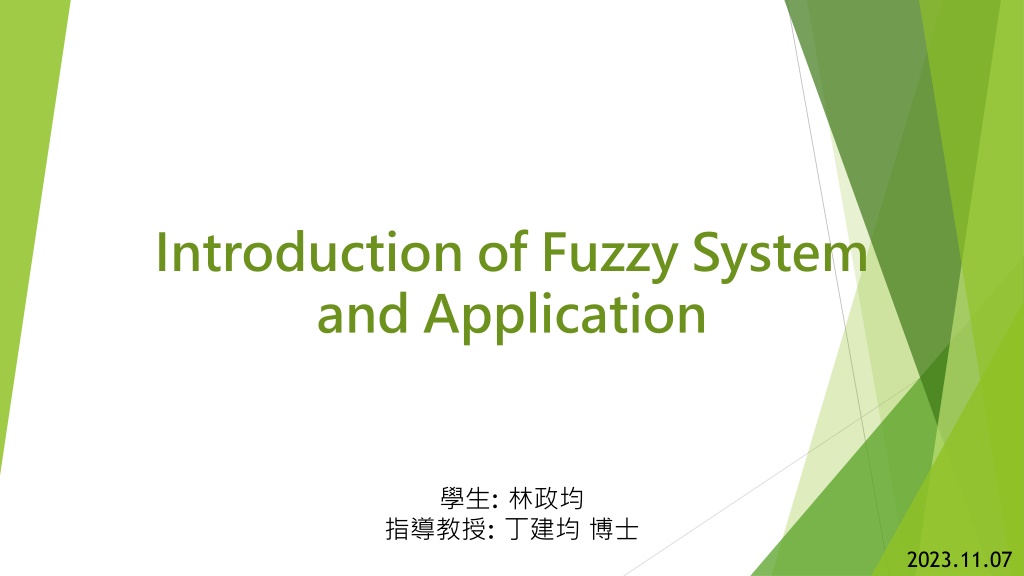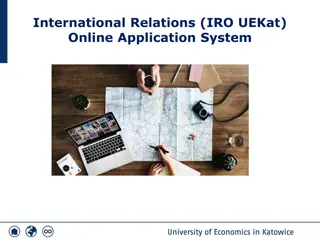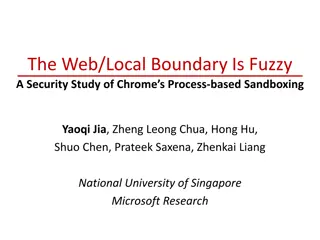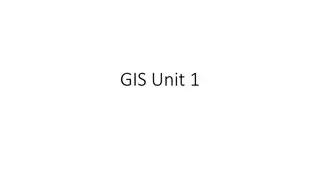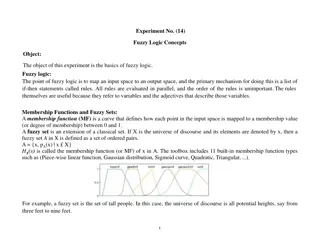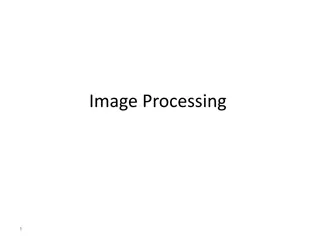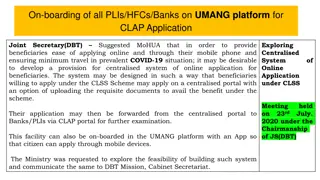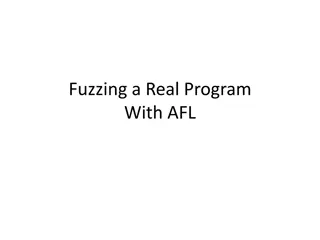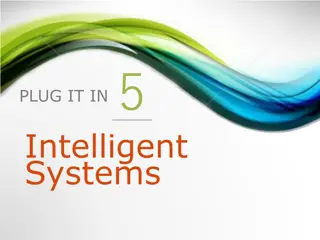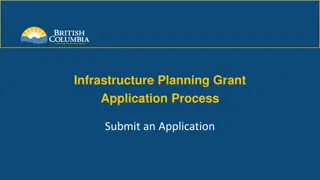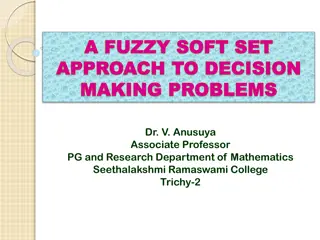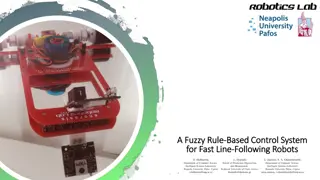Introduction of Fuzzy System and Application
Fuzzy logic, introduced by Professor Zadeh in 1965, offers a way to model linguistic fuzzy information, providing better generalization and error tolerance for nonlinear systems. Fuzzy sets remove sharp boundaries in classical sets, allowing for gradual transitions between membership and non-membership. Applications range from control engineering to decision-making and scheduling, making fuzzy logic valuable in various fields.
Download Presentation

Please find below an Image/Link to download the presentation.
The content on the website is provided AS IS for your information and personal use only. It may not be sold, licensed, or shared on other websites without obtaining consent from the author.If you encounter any issues during the download, it is possible that the publisher has removed the file from their server.
You are allowed to download the files provided on this website for personal or commercial use, subject to the condition that they are used lawfully. All files are the property of their respective owners.
The content on the website is provided AS IS for your information and personal use only. It may not be sold, licensed, or shared on other websites without obtaining consent from the author.
E N D
Presentation Transcript
Introduction of Fuzzy System and Application : : 2023.11.07
Introduction Fuzzy logic is a method proposed by Professor Zadeh in 1965 to use mathematical models to describe linguistic fuzzy information. We can regard it as an extension of traditional set theory. The advantage of fuzzification is that it can provide better generalization, error tolerance, and be more suitable for nonlinear systems applied in the real world. The application fields of fuzzy logic include: 1. Control Engineering (intelligent control) 2. Signal Processing (image processing, speech recognition) 3. Quantitative Analysis 4. Expert System 5. Decision 6. Scheduling
Fuzzy Set A classical set is a collection of distinct object. Let U be a universe of discourse. The characteristic function ?? of a crisp set A, in U takes its values in {0,1} and is defined as ??? = 1, 0, ?? ??? ???? ?? ? ? ?? ??? ???? ?? ? ? The boundary of set A is rigid and sharp and performs a two-class dichotomization (i.e., x A or x A), and the universe of discourse U is a crisp set.
Fuzzy Set A fuzzy set, on the other hand, introduces vagueness by eliminating the sharp boundary that divides members from nonmembers in the group. The transition between full membership and non-membership is gradual rather than abrupt. A fuzzy set A in the universe of discourse U can be defined as a set of ordered pairs, ? = (?,??(?)) ? ? where ??( ) is called the membership function (or characteristic function) of A, and ??? is the grade (or degree) of membership of x in A, which indicates the degree that x belongs to A
Fuzzy Set Let U be the real line and let crisp set A represent real numbers which are greater than 5. ??? = 1, ? 5 ? < 5 ? = (?,??(?)) ? ? 0, Reference: Chin-Teng Lin and C.S. George Lee, Neural Fuzzy Systems: A Neuro-Fuzzy Synergism to Intelligent Systems
Fuzzy Set Assume that in an examination, all the possible scores are U = { 10,20,..., 100}. Consider three fuzzy sets, A "High Score," B "Medium Score," and C "Low Score," whose membership functions are defined as Reference: Chin-Teng Lin and C.S. George Lee, Neural Fuzzy Systems: A Neuro-Fuzzy Synergism to Intelligent Systems
Support of Fuzzy Set The support of a fuzzy set A is the crisp set of all x U such that ??? > 0. That is, ???? ? = ? ? ??? > 0 Then we have ???? ? =???? "??? ?????" = 50,60,70,80,90,100 ???? ? =???? "?????? ?????" = 30,40,50,60,70,80 ???? ? =???? "??? ?????" = 10,20,30,40,50,60,70 Reference: Chin-Teng Lin and C.S. George Lee, Neural Fuzzy Systems: A Neuro-Fuzzy Synergism to Intelligent Systems
Membership Function 0 x a 0 x a x a a x b x a ( ) 2 b 1 a x m a x b i = ( ) exp x = ( ) b x x c b a A 2 i = A ( ) x 2 c x A d x b x c c x d c 0 b d 0 c c x d x Triangular Trapezoidal Gaussian Reference: Chin-Teng Lin and C.S. George Lee, Neural Fuzzy Systems: A Neuro-Fuzzy Synergism to Intelligent Systems
Membership Function 0 x a 2 + 2 x a a b 2 a x x ( ; , ) S 1 x b ( a b x b b a = = ( ; , ) ( ; , ) S x a b x a b 2 + + 2 ; , ) S b b a x b x b a b 1 2 x b b a 1 x b Pi-shaped S-shaped Reference: Chin-Teng Lin and C.S. George Lee, Neural Fuzzy Systems: A Neuro-Fuzzy Synergism to Intelligent Systems
Set-theoretic Operations Complement: When ??? > [0, 1], the complement of A, denoted as ? , is defined by its membership function as ? ?? = 1 ??? , ? ? Intersection: The intersection of fuzzy sets A and B is denoted as A B and is defined by ?? ?? = min [??? , ??? ] ??? ??? , ? ? Union: The union of fuzzy sets A and B is denoted as A B and is defined by ?? ?? = m??[??? , ??? ] ??? ??? , ? ? Fuzzy set A and B The complement of A The intersection of A and B The union of A and B Reference: Chin-Teng Lin and C.S. George Lee, Neural Fuzzy Systems: A Neuro-Fuzzy Synergism to Intelligent Systems
Set-theoretic Operations Equality: A and B are equal if and only if ???= ??? , ? ? Degree of Equality: To check the degree of equality of two fuzzy sets, we can use the similarly measure: ? ?,B degree A = B =|? ?| |? ?| Subset: A is a subset of B, that is A B, if and only if ??? ??? , ? ? Proper Subset: If A B and A B, then A is a proper subset of B, that is, A B. Again, the definition of subset is crisp. To check the degree that A is a subset of B, we can use the subsethood measure: ? ?,B degree A B =|? ?| |?|
Fuzzy Logic Linguistic Variable: A linguistic variable is a variable whose values are words or sentences in a natural or artificial language. E.g. temperature, speed, age, etc. A linguistic variable is characterized by a quintuple (x, T(x), U, G, M) in which x is the name of the variable; T(x) is the term set of x; that is, the set of names of linguistic values of x with each value being a fuzzy variable defined on U; G is a syntactic rule for generating the names of values of x; and M is a semantic rule for associating with each value of x its meaning.
Fuzzy Logic If speed is a linguistic variable with U = [0, 100], that is, x = speed, then its term set T(speed) could be T(speed) = { very slow, slow, moderate, fast, ... } The semantic rule M could be defined as M(slow) = fuzzy set for a speed below about 40 mph with ????? M(moderate) = fuzzy set for a speed close to 50 mph with ????????? M(fast) = fuzzy set for a speed above about 70 mph with ????? Reference: Chin-Teng Lin and C.S. George Lee, Neural Fuzzy Systems: A Neuro-Fuzzy Synergism to Intelligent Systems
Fuzzy Logic Control Systems The typical architecture of a FLC, which is comprised of four principal components: a fuzzifier, a fuzzy rule base, an inference engine, and a defuzzifier. Reference: Chin-Teng Lin and C.S. George Lee, Neural Fuzzy Systems: A Neuro-Fuzzy Synergism to Intelligent Systems
Fuzzifier A fuzzifier performs the function of fuzzification which is a subjective valuation to transform measurement data into valuation of a subjective value. Hence, it can be defined as a mapping from an observed input space to labels of fuzzy sets in a specified input universe of discourse 1. Fuzzy singleton 2. Gaussian membership function ( ) 2 = 1 x x x x 0 0 = = ( ) ( ) exp x x A A 2 0 x x 0
Fuzzy Rule Base Fuzzy rules are characterized by a collection of fuzzy IF-THEN rules in which the preconditions and consequents involve linguistic variables. The most common types of fuzzy rules: 1. Linguistic Fuzzy Rule (Mamdani s Fuzzy Model) 2. Functional Fuzzy Rule (Sugeno s Fuzzy Model) 3. Tsukamoto s Method Linguistic Fuzzy Rule: Precondition x is x0 and y is y0 Fuzzy rule 1 If x is A1 and y is B1 Then z is C1 Fuzzy rule 2 If x is A2 and y is B2Then z is C2 Functional Fuzzy Rule: Precondition x is x0 and y is y0 Fuzzy rule 1 If x is A1 and y is B1 Then z is f1(x,y) Fuzzy rule 2 If x is A2 and y is B2Then z is f2(x,y)
Application water temperature control The temperature from signal Fuzzy Neural Network Result
Application edge detection Load image and convert to grayscale image
Application edge detection Obtain the vertical and horizontal gradient
Application edge detection Fuzzifier
Application edge detection Fuzzy Rule Base
Application edge detection Defuzzifier
Reference: [1] Chin-Teng Lin and C.S. George Lee, Neural Fuzzy Systems: A Neuro-Fuzzy Synergism to Intelligent Systems
